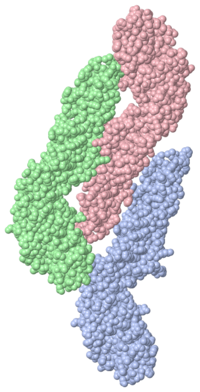Sandbox 1k4r
From Proteopedia
| Line 9: | Line 9: | ||
{{ABSTRACT_PUBMED_11893341}} | {{ABSTRACT_PUBMED_11893341}} | ||
===Etiology=== | ===Etiology=== | ||
| - | Dengue is | + | Dengue virus is a mosquito borne illness and is a major threat in most of the tropical and sub-tropical countries around the world. There are four related subtypes of the Dengue virus. Dengue is not transmitted directly from person-to-person and symptoms range from a mild fever, to incapacitating high fever, with severe headache, pain behind the eyes, muscle and joint pain, and rash. There is no vaccine or any specific medicine to treat dengue. People who have dengue fever should rest, drink plenty of fluids and reduce the fever using paracetamol or see a doctor. |
==About this Structure== | ==About this Structure== | ||
| - | + | ||
[[Image:1k4rVirion.png|200px]] | [[Image:1k4rVirion.png|200px]] | ||
Revision as of 03:29, 23 October 2013
Contents |
Dengue Virus
| |||||||||
| 1k4r, resolution 24.00Å () | |||||||||
|---|---|---|---|---|---|---|---|---|---|
| Related: | 1svb | ||||||||
| |||||||||
| |||||||||
| Resources: | FirstGlance, OCA, RCSB, PDBsum | ||||||||
| Coordinates: | save as pdb, mmCIF, xml | ||||||||
Structure of Dengue Virus
The first structure of a flavivirus has been determined by using a combination of cryoelectron microscopy and fitting of the known structure of glycoprotein E into the electron density map. The virus core, within a lipid bilayer, has a less-ordered structure than the external, icosahedral scaffold of 90 glycoprotein E dimers. The three E monomers per icosahedral asymmetric unit do not have quasiequivalent symmetric environments. Difference maps indicate the location of the small membrane protein M relative to the overlaying scaffold of E dimers. The structure suggests that flaviviruses, and by analogy also alphaviruses, employ a fusion mechanism in which the distal beta barrels of domain II of the glycoprotein E are inserted into the cellular membrane.
Structure of dengue virus: implications for flavivirus organization, maturation, and fusion., Kuhn RJ, Zhang W, Rossmann MG, Pletnev SV, Corver J, Lenches E, Jones CT, Mukhopadhyay S, Chipman PR, Strauss EG, Baker TS, Strauss JH, Cell. 2002 Mar 8;108(5):717-25. PMID:11893341
From MEDLINE®/PubMed®, a database of the U.S. National Library of Medicine.
Etiology
Dengue virus is a mosquito borne illness and is a major threat in most of the tropical and sub-tropical countries around the world. There are four related subtypes of the Dengue virus. Dengue is not transmitted directly from person-to-person and symptoms range from a mild fever, to incapacitating high fever, with severe headache, pain behind the eyes, muscle and joint pain, and rash. There is no vaccine or any specific medicine to treat dengue. People who have dengue fever should rest, drink plenty of fluids and reduce the fever using paracetamol or see a doctor.
About this Structure
Reference
- Kuhn RJ, Zhang W, Rossmann MG, Pletnev SV, Corver J, Lenches E, Jones CT, Mukhopadhyay S, Chipman PR, Strauss EG, Baker TS, Strauss JH. Structure of dengue virus: implications for flavivirus organization, maturation, and fusion. Cell. 2002 Mar 8;108(5):717-25. PMID:11893341
Categories: Dengue Virus | RCSB PDB Molecule of the Month | Viruses | Baker, T S. | Chipman, P R. | Corver, J. | Jones, C T. | Kuhn, R J. | Lenches, E. | Mukhopadhyay, S. | Pletnev, S V. | Rossmann, M G. | Strauss, E G. | Strauss, J H. | Zhang, W. | Dengue virus | Flaviviridae | Flavivirus | Glycoprotein e from tick-borne encephalitis virus | Icosahedral virus | Virus


